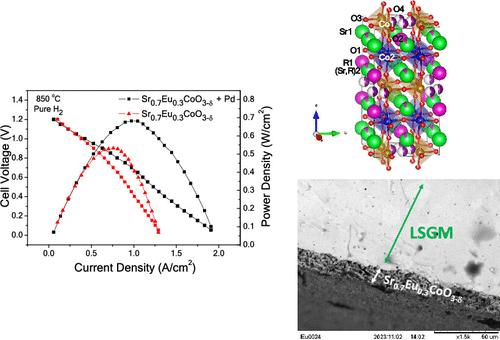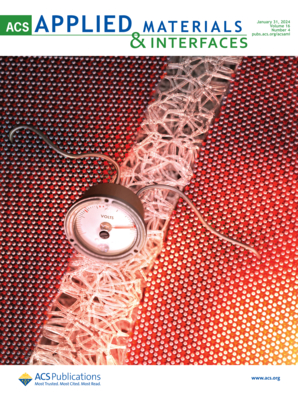Sr0.7R0.3CoO3-δ (R = Gd, Eu, and Sm) Perovskites Infiltrated with Pd: Enhancing the Performance as Cathode Materials in Solid Oxide Fuel Cells
IF 8.3
2区 材料科学
Q1 MATERIALS SCIENCE, MULTIDISCIPLINARY
引用次数: 0
Abstract
Perovskites based on Sr0.7R0.3CoO3-δ (R = Gd, Eu, and Sm) were prepared to be used as cathodes in solid oxide fuel cells (SOFC). The materials were synthesized using the citrate-nitrate route and thermal treatments in air atmosphere. The identification of the phases was performed using high-resolution synchrotron X-ray powder diffraction (SXRD) at room temperature to determine the features of the crystalline structure and to identify oxygen vacancies in the materials. SXRD data revealed a significant presence of long-range ordered oxygen vacancies concentrated at the O2 and O4 oxygen positions, exhibiting large displacement factors, defined in a tetragonal perovskite-type superstructures with I4/mmm space group. Subsequently, thermal properties were analyzed to determine the thermal expansion coefficients and their compatibility with the other components of the cell. Additionally, thermal analysis allowed us to identify a reduction in the oxygen content as the temperature increases. A single-cell test conducted in electrolyte-supported configuration at 800 and 850 °C with values surpassing 750 mW/cm2 demonstrated the successful utilization of these perovskites as cathode materials in SOFCs. Furthermore, the materials were further optimized by improving the performance of the cells with an additional process: infiltration with a Pd(NO3)2 solution.

渗入钯的 Sr0.7R0.3CoO3-δ(R = Gd、Eu 和 Sm)包晶:提高固体氧化物燃料电池阴极材料的性能
制备了基于 Sr0.7R0.3CoO3-δ(R = Gd、Eu 和 Sm)的过氧化物,以用作固体氧化物燃料电池(SOFC)的阴极。这些材料采用柠檬酸盐-硝酸盐路线合成,并在空气中进行热处理。在室温下使用高分辨率同步辐射 X 射线粉末衍射 (SXRD) 对相进行了鉴定,以确定晶体结构的特征,并识别材料中的氧空位。SXRD 数据揭示了长程有序氧空位的显著存在,这些氧空位集中在 O2 和 O4 氧位置,表现出较大的位移因子,形成了具有 I4/mmm 空间群的四方包晶型超结构。随后,我们对热性能进行了分析,以确定热膨胀系数及其与电池其他组件的兼容性。此外,通过热分析,我们还确定了氧含量会随着温度的升高而降低。在 800 和 850 °C 的电解质支持配置下进行的单电池测试显示,其值超过了 750 mW/cm2,这表明这些过氧化物在 SOFC 中成功地用作阴极材料。此外,这些材料还得到了进一步优化,通过额外的工艺提高了电池的性能:渗入 Pd(NO3)2 溶液。
本文章由计算机程序翻译,如有差异,请以英文原文为准。
求助全文
约1分钟内获得全文
求助全文
来源期刊

ACS Applied Materials & Interfaces
工程技术-材料科学:综合
CiteScore
16.00
自引率
6.30%
发文量
4978
审稿时长
1.8 months
期刊介绍:
ACS Applied Materials & Interfaces is a leading interdisciplinary journal that brings together chemists, engineers, physicists, and biologists to explore the development and utilization of newly-discovered materials and interfacial processes for specific applications. Our journal has experienced remarkable growth since its establishment in 2009, both in terms of the number of articles published and the impact of the research showcased. We are proud to foster a truly global community, with the majority of published articles originating from outside the United States, reflecting the rapid growth of applied research worldwide.
 求助内容:
求助内容: 应助结果提醒方式:
应助结果提醒方式:


